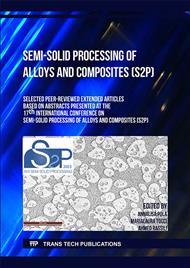p.15
p.21
p.27
p.33
p.39
p.47
p.55
p.61
p.69
Flow Length Influence of Cores Made of High-Temperature Composite in Semi-Solid AZ91 Produced in Thixomolding
Abstract:
Die casting of metallic materials is a highly economical manufacturing process for producing complex functionally integrated components close to the final shape. Thixomolding of magnesium alloys is a special process of die casting. In this process, the magnesium alloy granulate is brought to a semi solid state in a screw conveyor and then injected into the mould. The production of the casting material in the Thixomolding screw allows the temperature conditions to be set for thermally controlled solid content. These are produced by heating the Mg granulate above solidus temperature and have significantly lower casting temperature compared to conventional die casting.In this study, a flow length tool for semi solid AZ91 is designed and flow length tests are performed. Also the general use of a composite material cores in semi-solid magnesium Thixomolding and their influence on flow length are investigated. Cast-in cores allow the reproduction of complex internal hollow geometries of castings or the integration of special materials.
Info:
Periodical:
Pages:
39-45
Citation:
Online since:
August 2023
Price:
Сopyright:
© 2023 Trans Tech Publications Ltd. All Rights Reserved
Share:
Citation:



